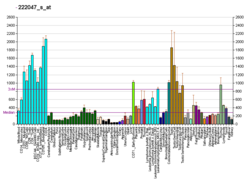Serrate RNA effector molecule homolog (SRRT) also known as arsenite-resistance protein 2 (ARS2) is a protein that in humans is encoded by the SRRT gene.
The SRRT gene product plays a role in RNA-mediated gene silencing (RNAi) by miRNAs. Independently of its activity on miRNAs, it is necessary and sufficient to promote neural stem cell self-renewal, by directly binding to the SOX2 promoter and positively regulating its transcription. It enables the binding activity of the mRNA cap binding complex and the adaptor activity of certain protein molecules. It can be found in the nucleoplasm and is part of the ribonucleoprotein complex. It is involved in cell cycle progression around the S phase.
It does not directly confer arsenite resistance but rather modulates arsenic sensitivity. Diseases associated with SRRT include spondylocostal dysostosis and cerebral arteriopathy.
References
- ^ GRCh38: Ensembl release 89: ENSG00000087087 – Ensembl, May 2017
- ^ GRCm38: Ensembl release 89: ENSMUSG00000037364 – Ensembl, May 2017
- "Human PubMed Reference:". National Center for Biotechnology Information, U.S. National Library of Medicine.
- "Mouse PubMed Reference:". National Center for Biotechnology Information, U.S. National Library of Medicine.
- "Entrez Gene: ARS2 ARS2 protein".
- "SRRT Gene". GeneCards. Retrieved 31 January 2023.
Further reading
- Rossman TG, Wang Z (1999). "Expression cloning for arsenite-resistance resulted in isolation of tumor-suppressor fau cDNA: possible involvement of the ubiquitin system in arsenic carcinogenesis". Carcinogenesis. 20 (2): 311–6. doi:10.1093/carcin/20.2.311. PMID 10069470.
- Wilson MD, Riemer C, Martindale DW, et al. (2001). "Comparative analysis of the gene-dense ACHE/TFR2 region on human chromosome 7q22 with the orthologous region on mouse chromosome 5". Nucleic Acids Res. 29 (6): 1352–65. doi:10.1093/nar/29.6.1352. PMC 29746. PMID 11239002.
- Scherer SW, Cheung J, MacDonald JR, et al. (2003). "Human chromosome 7: DNA sequence and biology". Science. 300 (5620): 767–72. Bibcode:2003Sci...300..767S. doi:10.1126/science.1083423. PMC 2882961. PMID 12690205.
- Di Y, Li J, Zhang Y, et al. (2004). "HCC-associated protein HCAP1, a variant of GEMIN4, interacts with zinc-finger proteins". J. Biochem. 133 (6): 713–8. doi:10.1093/jb/mvg091. PMID 12869526.
- Obuse C, Yang H, Nozaki N, et al. (2004). "Proteomics analysis of the centromere complex from HeLa interphase cells: UV-damaged DNA binding protein 1 (DDB-1) is a component of the CEN-complex, while BMI-1 is transiently co-localized with the centromeric region in interphase". Genes Cells. 9 (2): 105–20. doi:10.1111/j.1365-2443.2004.00705.x. PMID 15009096. S2CID 21813024.
- Beausoleil SA, Jedrychowski M, Schwartz D, et al. (2004). "Large-scale characterization of HeLa cell nuclear phosphoproteins". Proc. Natl. Acad. Sci. U.S.A. 101 (33): 12130–5. Bibcode:2004PNAS..10112130B. doi:10.1073/pnas.0404720101. PMC 514446. PMID 15302935.
- Ballif BA, Villén J, Beausoleil SA, et al. (2005). "Phosphoproteomic analysis of the developing mouse brain". Mol. Cell. Proteomics. 3 (11): 1093–101. doi:10.1074/mcp.M400085-MCP200. PMID 15345747.
- Beausoleil SA, Villén J, Gerber SA, et al. (2006). "A probability-based approach for high-throughput protein phosphorylation analysis and site localization". Nat. Biotechnol. 24 (10): 1285–92. doi:10.1038/nbt1240. PMID 16964243. S2CID 14294292.
- Szafranski K, Schindler S, Taudien S, et al. (2007). "Violating the splicing rules: TG dinucleotides function as alternative 3' splice sites in U2-dependent introns". Genome Biology. 8 (8): R154. doi:10.1186/gb-2007-8-8-r154. PMC 2374985. PMID 17672918.
This article on a gene on human chromosome 7 is a stub. You can help Misplaced Pages by expanding it. |







